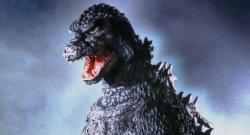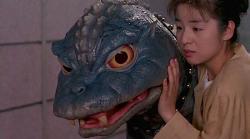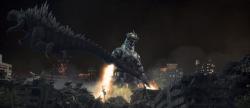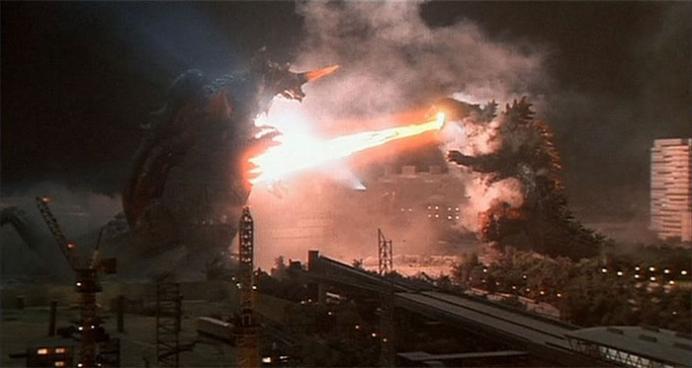Reviews
Gojira tai Desutoroia
Takao Okawara
Japan, 1995
Credits
Review by Greg Londe
Posted on 22 February 2013
Source YouTube
Categories The Compleat Godzilla
At forty years old, the irradiated monster of the melancholic and cynical Godzilla vs. Destoroyah finds himself having something of a half-life crisis. Godzilla emerges from the sea covered in a blotchy rash of smoldering magma, looking dyspeptic and confused; we learn that his heart, a giant nuclear reactor, is at last on the verge of a meltdown. This is the central, sentimental metaphor for a film series burning itself to the ground. After his decades of titanic battles, Godzilla’s final foe will be his own poisoned core. As the last entry in Toho Studio’s Heisei series, the film offers a surprisingly wistful look back at the original Godzilla on its anniversary, while preparing for the gaijin appropriation of Roland Emmerich’s puffy 1998 American reboot by killing off the towering icon’s Toho form. This trans-Pacific changing of the guard resulted from a multi-million dollar deal between Toho and American Tri-Star Pictures, yet the tone of Godzilla vs. Destoroyah is hardly one of congratulatory boardroom handshakes. An air of both commemoration and bitter, inevitable obsolescence hangs over the proceedings: one more round of rubber suits and crushed miniatures before Godzilla will be blown into a shower of slick pixels to menace Manhattan, via Hollywood.
There was to be something different about Godzilla vs. Destoroyah, but it was the same old difference. Advertising for the film had courted worldwide headlines: Godzilla would not survive this battle. With death a foregone conclusion, and one that was meant to seem more final than usual, the film plays like The Passion of Godzilla, the lizard bearing his glowing wounds through the marketplace. Unclear about the nature of Godzilla’s ailment, the monster-monitoring G-Summit enlists a Japanese college student, Kenichi Yamane - grandson of Dr. Kyohei Yamane, hero of the 1954 original - to diagnose the dragon. He is dubbed in your voice, American, and there is a shine in his eye that’s halfway hopeful; his college thesis, a “consideration of Godzilla’s structure,” reveals the imminent collapse of the telltale heart, while he displays computer-generated projections of the blast-radius that will result when Godzilla’s foundational allegory reverts, at last, into an actual atomic catastrophe.
At this point the movie becomes a drama about history and the film series’ constant repetitions, with the only clear way to avert explosion being the Oxygen Destroyer that was deployed back in 1954. 63-year-old Momoko Kochi reprises her role as Emiko Yamane from the original movie, issuing a warning about the possible side effects of a new formula for the Oxygen Destroyer. We rack-focus between deliberations over its strategic use to a black and white photograph of Dr. Serizawa, the self-sacrificing discoverer of the device in a framed still from Godzilla. The traditional re-purposing of footage from previous entries in the Godzilla series now becomes an overt and doleful reminder of cyclical violence. Emiko Yamane is correct: mutated by the new Oxygen Destroyer, a tank of unicellular baddies - in vitro Pokémon, perhaps - begin to grow and infest the sewers, evolving rapidly into crustacean horrors who overwhelm the military’s ability to contain them. Named “Destoroyah” as they gradually coalesce into a giant crimson threat, the resulting grotesque will fight Godzilla to the bitter end.
More than simply a remainder of the 1954 Godzilla’s pyrrhic victory, Destoroyah is a stand-in for a legion of imitators in the West. Destoroyah’s mutability allows the creature to become whatever avatar of Hollywood spectacle might awkwardly fit a scene: in one moment, its shape mimics the Alien Queen from Aliens—a telescoping, fanged tongue reaching perilously close to our heroine’s face; a daggered tail spearing a soldier—and in the next, it stomps around an overturned car, nosing into the wreckage like the T-Rex in Jurassic Park. Godzilla, a wounded animal, is swarmed by a multitude of plagiarisms. They kill his grown son. The filial legacy is cut short by echoes and impostors who, aptly, eat Junior’s heart in the movie’s most gruesome spectacle.
Why should such convoluted acts of cinematic memorial and acrid competition be the proper form for Godzilla’s last bow? Consider a very different memorial narrative: in 1993, curators at the U.S. National Air and Space Museum began planning for an exhibition about the fiftieth anniversary of Hiroshima and Nagasaki, entitled “The Crossroads: The End of World War II, the Atomic Bomb, and the Onset of the Cold War.” The centerpiece was to be the restored fuselage of the Enola Gay, the B-29 that dropped the Hiroshima Bomb, which had long been in the possession of the Museum, moldering on the lot of an exposed storage depot. The Smithsonian’s initial proposal stressed the “debatable character of the atomic bombings” and promised a closing video that “will include the perspectives of a whole range of people—both historical actors, survivors, scholars and ordinary people, both Japanese and American”.1 Almost immediately, the plan met with controversy for its alleged partisanship toward the suffering of Japanese casualties. An initial denunciation from Monroe Hatch, the Executive Director of the Air Force Association led to an open letter in the following year from twenty-four members of Congress suggesting their “concern and dismay” at the Smithsonian’s representation of Japan “more as an innocent victim than a ruthless aggressor.” Governmental discomfort with the “revisionism” of the exhibition frequently centered on the plan to display a schoolgirl’s battered lunch box, recovered from Hiroshima’s aftermath and still filled with the carbonized remains of peas and rice, among other artifacts that would form what the Museum called the “emotional center” of the exhibit. Detractors pointed out that no comparable reliquary would be gathered from the broken watches and yellowed photographs of Americans whose lives were lost in the War, which was supposedly being deemed, on the whole, an immoral act of U.S. aggression with the twin atomic bombs given as the unequivocal flash point of the Cold War.
By the end of 1994, with historians at the Museum facing mounting pressure from Congress, the Air Force Association, the Retired Officers Association, and the Veterans of Foreign Wars, the exhibition was cancelled, and Martin Harwitt, director of the Air and Space Museum, was forced to resign. The Enola Gay went on display, in a more straightforward chronicle of the military and technological history of the War’s end, in 1995, as Godzilla vs. Destoroyah entered Japanese cinemas. This sanitized display, which became the most popular special exhibition in the Museum’s history, closed in May 1998, the same month in which Emmerich’s Godzilla opened on screens around the world. True to the willful cultural amnesia and disclaimed responsibility at the heart of the exhibition’s backlash, Godzilla ‘98 is the product of French nuclear tests in Polynesia.
Here in 1995, between the debris of the Berlin Wall and the rubble of the Twin Towers, Godzilla is unmoored from history, a relic of the Cold War who cannot yet allegorize the new terror in the way of a Cloverfield. He is thus ready to be sacrificed on the altar of international corporate synergy in a period that was ripe for the death and strangely prismatic resurrection of titans: Godzilla, Superman, Karl Marx. Destoroyah bears a striking resemblance to Doomsday, the Man of Steel’s fateful 1992 antagonist: both are bone-spurred and soulless punch-machines whose ability to overwhelm an icon feels arbitrary. Those who opened their poly-bagged copies of Dan Jurgens and Brett Breeding’s Superman #75 found a black armband inside—global “mourning” given shape by a bizarre tip-in from the marketing department. In Hibiya Park, Tokyo, a puny brass statue of Godzilla was erected on a stone pedestal to mark his passing. We were told it was time to put our giants to rest. The rhetoric of the “end of history” - the perceived resolution of the Cold War’s dominant logic of bilateral X vs. Y brawls into a tenuous and ultimately brief “Pax Americana” - prepared audiences to view these deaths as events both novel and final, when in fact neither was the case.2 In such storylines - signal works of 1990s global art - we see pop culture cautiously testing out what it would feel like to lack presiding guardians or major foes in a world after liberal democracy’s purported global triumph.
As composer Akira Ifukube, who wove elements of his score for Godzilla into Godzilla vs. Destoroyah, noted, “In the original film, Godzilla’s death is the resolution of a tragedy, and it somehow represents hope. But in Godzilla vs. Destoroyah, I believe it is more pessimistic”.3 Ultimately the film seems worn out by a city-stomping valediction that it knows in its nuclear heart will be temporary. Just another day on the job. As in his earliest films, introduced when the 20th century itself had entered middle age, Godzilla’s slow wobble embodies the atomic bomb as a cranky brute, upset at having been roused from his nap. This is the sense of exhausted, quotidian monstrosity conveyed in James Richardson’s poem “My Godzilla”, which contains a line that could have appeared on Godzilla vs. Destoroyah’s poster: “Forty years on: you’re pretty sure what’s coming”.4 “Responding to the contemporary imperative,” writes Takayuki Tatsumi of the 1995 feature, “Godzilla himself could not help but become neutral, only to lose thus his cinematographic appeal”.5 Godzilla cannot exist in a world of consensus. Richardson concludes his poem with a metaphor that slyly reveals domestic comfort—the brutal, seemingly neutral everyday—to be culpable in distant suffering, pulling destruction away from the site of a singular cataclysm and rooting it the world of lazy consumption and dogged daily work:
The script, alas, is not what time re-writes.
He’s how you look in your bathrobe in the morning,
how you keep smashing through the day,
fired at, invisibly hurt, intent,
litter of ages swirling around your ankles,
the grit grit grit of your soles their tiny, unheard cries.
As Godzilla prepared to go American, Americans could hardly remember that they had been Godzilla at the start.
- http://www.afa.org/media/enolagay/chrono.asp ↩
- In the U.S., the phoenix-like death and renewal of superheroes had long been standard operating procedure at least since the moment when Golden Age characters of the 1940s were re-born in the 1960s. This form of recreation was systematized in the mid-80s when Marvel’s Secret Wars and DC’s Crisis on Infinite Earths crossovers codified the procedure as a way to slice through Gordian knots in the continuity of collectively authored fictional universes, or to reset characters to suit their changing times, or to sell a shitload of toys. The dragon in (nuclear) winter had made perishing into a habit for largely the same reasons. ↩
- In Ryfle, Steve. Japan’s Favorite Mon-Star: The Unauthorized Biography of ‘The Big G.’ ECW Press, 1998. Page 316. ↩
- http://www.slate.com/articles/arts/poem/2000/06/my_godzilla.html ↩
- Tatsumi, Takayuki. Full Metal Apache: Transactions Between Cyberpunk Japan and Avant-Pop America. Duke University Press, 2006. Page 175. ↩
More The Compleat Godzilla
-

Godzilla
1954 -

Godzilla Raids Again
1955 -

King Kong vs. Godzilla
1962 -

Mothra vs. Godzilla
1964 -

Ghidorah, the Three-Headed Monster
1964 -

Invasion of Astro-Monster
1965 -

Ebirah, Horror of the Deep
1966 -

Son of Godzilla
1967 -

Destroy All Monsters!
1968 -

All Monsters Attack
1969 -

Godzilla Vs. Hedorah
1971 -

Godzilla vs. Gigan
1972 -

Godzilla vs. Megalon
1973 -

Godzilla vs. Mechagodzilla
1974 -

Terror of Mechagodzilla
1975 -

The Return of Godzilla
1984 -

Godzilla vs. Biollante
1989 -

Godzilla vs. King Ghidorah
1991 -

Godzilla vs. Mothra
1992 -

Godzilla vs. Mechagodzilla
1993 -

Godzilla vs. SpaceGodzilla
1994 -

Godzilla vs. Destoroyah
1995 -

Godzilla 2000
1999 -

Godzilla vs. Megaguirus
2000 -

Godzilla, Mothra and King Ghidorah: Giant Monsters All-Out Attack
2001 -

Godzilla Against Mechagodzilla
2002 -

Godzilla: Tokyo S.O.S.
2003 -

Godzilla: Final Wars
2004
We don’t do comments anymore, but you may contact us here or find us on Twitter or Facebook.



